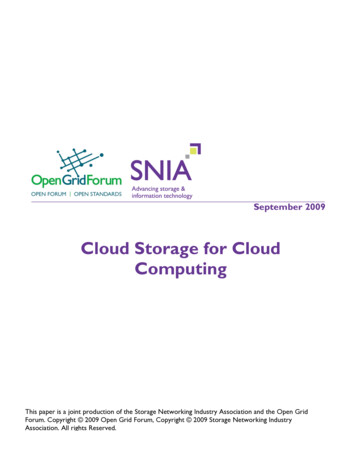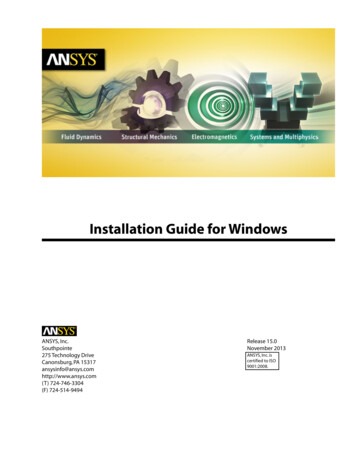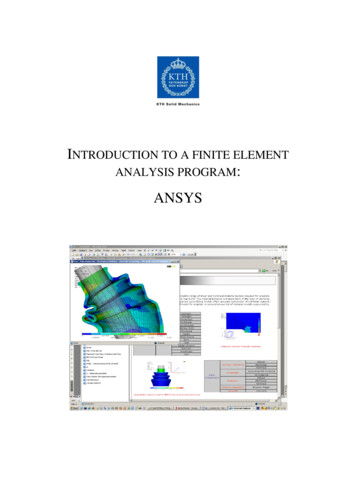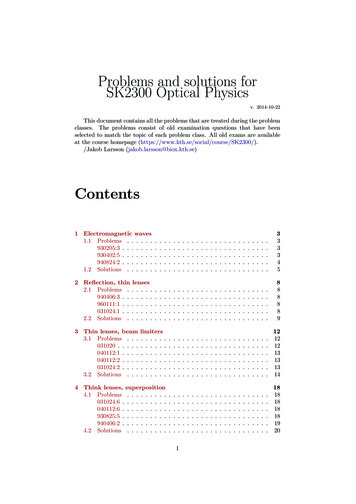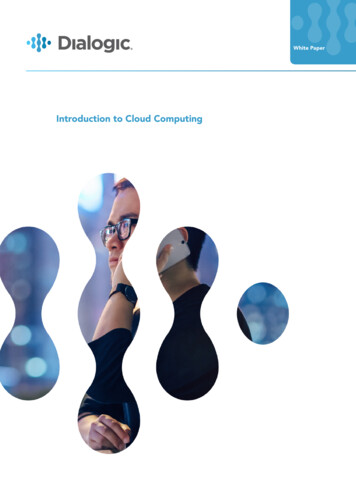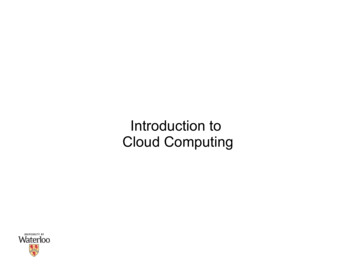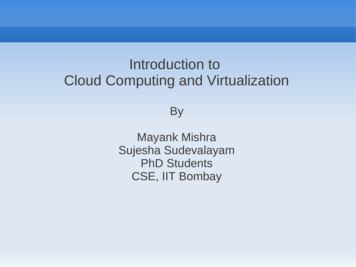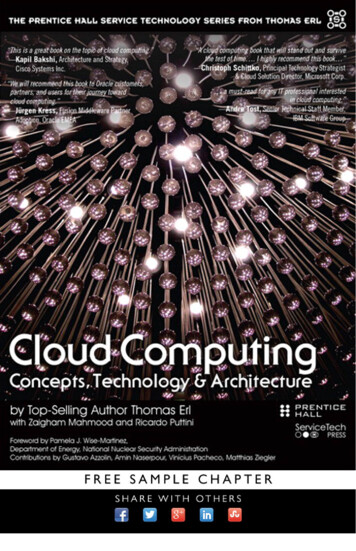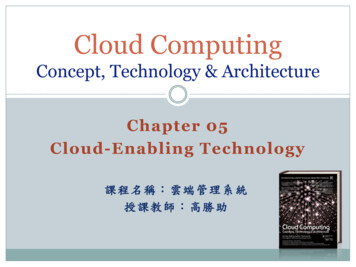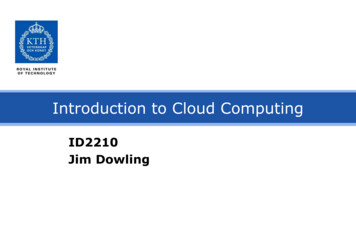
Transcription
Introduction to Cloud ComputingID2210Jim Dowling
Cloud Computing Cloud computing is thedelivery of hostingservices that are providedto a client over theInternet.- Enable large-scale serviceswithout up-front investment.
VM’S LAUNCHINGVM LAUNCHING![XKCD Comic 303]
Clouds are Elastic NIST Definition of Cloud Computing"Cloud computing is a model for enablingconvenient, on-demand network access to a sharedpool of configurable computing resources (e.g.,networks, servers, storage, applications, andservices) that can be rapidly provisioned andreleased with minimal management effort or serviceprovider interaction."
Supporting Technologies Enormous computer data-centres containingcommodity hardware. Virtualization of computation, storage, andcommunication.- Turn hardware and networking into software! Achieve economies of scale.- Reduce costs of electricity, bandwidth, hardware, software anduse low-cost locations.- Lower-cost than provisioning own hardware. Large-scale distributed systems services, such asNoSQL datastores, object stores, and distributedfilesystems, have enabled developers to build scalablecloud computing applications.
Cloud Computing Essentials Cloud computing is Utility Computing- Cloud services are controlled and monitored by the cloudprovider through a pay-per-use business model. An ideal cloud computing platform is:- efficient in its use of resources- scalable- elastic- self-managing- highly available and accessible- inter-operable and portable
Cloud Properties Resource efficiency: computing and networkresources are pooled to provide services to multipleusers. Resource allocation is dynamically adaptedaccording to user demand. Elasticity: computing resources can be rapidly andelastically provisioned to scale up, and released toscale down based on consumer’s demand.
Cloud Properties Self-managing services: a consumer can provisioncloud services, such as web applications, servertime, processing, storage and network as neededand automatically without requiring humaninteraction with each service’s provider Accessible and highly available: cloud resourcesare available over the network anytime andanywhere and are accessed through standardmechanisms that promote use by different types ofplatform (e.g., mobile phones, laptops, and PDAs).
Over or Under-ProvisioningLess andlessdemand.Shaded area is unused capability.Shaded area representsrequests not served.
Dynamic Provisioning In traditional computing model, two commonproblems :ResourcesResources- Underestimate system utilization which result in underprovisionCapacity21Time (days)3CapacityDemand1ResourcesDemandLoss Revenue23Loss UsersCapacityDemand123
Dynamic Provisioning Overestimate system utilization which results in lowutilizationResourcesCapacityUnused resourcesDemandTime How do we solve this problem?- Dynamically provision resources
Real world estimates Average server utilization is 5% to 20%. Peak workload exceeds the average by factors of 2to 10. Users provision for the peak. Peak loads may occur based on the time of day orbased on other factors (e.g. photo sharing after theholidays, drop/add within two weeks of start ofterm, etc.)
Public Clouds, Private Clouds
Deployment Model There are four primary cloud deployment models :- Public Cloud- Private Cloud- Community Cloud- Hybrid Cloud
Public Clouds Public clouds are owned by cloud service providerswho charge for the use of cloud resources. Basic characteristics:- Homogeneous infrastructure, Common policies- Shared resources and multi-tenancy- Leased or rented infrastructure- Economies of scale AWS/EC2 (Amazon) Azure (Microsoft) Google Cloud Platform. Rackspace.
Private Clouds The cloud infrastructure belongs to and is operatedby only one organization. Basic characteristics :- Heterogeneous infrastructure; Customized policies- Dedicated resources- In-house infrastructure; End-to-end control Examples include:
Other types of Clouds Community cloud- The cloud infrastructure is shared by several organizationsand supports a specific community that has sharedconcerns (e.g., mission, security requirements, policy, andcompliance considerations). Hybrid cloud- The cloud infrastructure is a composition of two or moreclouds (private, community, or public) that remain uniqueentities but are bound together by standardized orproprietary technology that enables data and applicationportability.
IaaS, PaaS and SaaS Infrastructure as a Service (IaaS) Platform as a Service (PaaS) Software as a Service (SaaS)SaaSPaaSApplicationsPackaged SoftwareIaaSPlatformOS & ApplicationStackPlatformOS & ApplicationStackInfrastructureServers · Storage· NetworkInfrastructureServers · Storage· NetworkInfrastructureServers · Storage· Network
Spectrum of Cloud UsersImage -look-withpretty-pictures.aspx
Virtualization Virtualization is the abstraction of logical resourcesaway from underlying physical resources. A hypervisor (or Virtual Machine Monitor (VMM))virtualizes a platform’s operating system.- The hypervisor manages OS’ as virtual machines (VMs) ,enabling multiple OS’ to share the same physical hardware.
Hypervisor’s Trap and Emulate Model The hypervisor’s virtualization paradigm is trap andemulate :- Normal instructions of guest OS run directly on processor in user mode.- System Calls CPU will trap to interrupt handler vector of Hypervisor. Hypervisor jump back into guest OS.- Hardware Interrupts Hardware makes CPU trap to interrupt handler of Hypervisor. Hypervisor jumps to corresponding interrupt handler of guest OS.- Privilege Instructions Running privilege instructions in guest OS will be trapped toHypervisor for instruction emulation. After emulation, the Hypervisor jumps back to guest OS.
Trap and Emulate Model (VMM Hypervisor)
VM Context Switching The hypervisor context switches virtual machines:1.2.3.4.5.6.7.Timer Interrupt in running VM.Context switch to Hypervisor.Hypervisor saves state of running VM.Hypervisor determines next VM to execute.Hypervisor sets timer interrupt.Hypervisor restores state of next VM.Hypervisor sets the program counter to timer interrupthandler of next VM.8. Next VM active.
VM Context Switching
Hypervisor Models[https://en.wikipedia.org/wiki/Hypervisor]
KVM (Kernel-based Virtual Machine) VMWare and Xen are the best-known virtualizationplatforms. KVM (Kernel-based Virtual Machine) is an opensource virtualization platform- Linux host OS- Run multiple virtual machines (Windows, MAC, etc) on yourlinux box- IO is virtualized using a device model in KVM- KVM requires a modified QEMU (open-source processoremulator) for its IO virtualization framework.- Type 1 Hypervisor, as it is a kernel-level module.
Virtualization using KVM in Linux KVM is a loadable kernel module- kvm.ko provides the core virtualization infrastructure- kvm-intel.ko / kvm-amd.ko processor specific modules
Virtual Machines are software – APIs to drive them.
OpenStack Compute REST API Features Authentication Servers- List Servers IPs- Create Server- Delete Server- Reboot Server Flavors (hardware config)- List Flavors- Get Flavor Details Images-List ImagesCreate Image/SnapshotGet Image DetailsDelete Image Backup Schedules- List Backup Schedules- Create/Update- Disable
Platform-as-a-Service (PaaS)
IaaS is not Enough IaaS provides virtual machines, but it cannot provideelastic computing by itself, where services scale upand down to meet user demand.- Dynamic provisioning Existing IaaS’ do not provide support for the sharingmiddleware platforms among different VMs- Multi-tenancy
Multi-tenancy Multi-tenancy is where a single instance of thesoftware runs on a server, serving multiple clients.- Think multiple users in a MySQL database- Java 9 should support multi-tenancy (many java programsrunning in the same JVM) The software should be able to provide a singleservice to all customers by setting configurations- More efficient use of server resources
IaaS - what you nfrastructure-as-a-Service
You might prefer this.FlinkSparkTezYARNHDFSConfigured stack of servers, dependencies, and firewalls and your app installed.A Platform-as-a-Service
Running on lots of machines Data CenterPaaSPaaSPaaSPaaSPaaSPaaSPaaSPaaSPaaS
Platform-as-a-Service (PaaS) Platform as a Service (PaaS) is a computingplatform that abstracts the infrastructure, OS, andmiddleware to drive developer productivity. PaaS leverages dynamic provisioning PaaS leverages multi-tenancy
Closed PaaS A closed PaaS provides a fixed set of services youcan use. You cannot install your own services. They are typically hosted at some IaaS provider.Closed PaaSHerokuSupported Langs/ServicesRuby, Node.js, JVM-langs,Python, SQL-DB, KV-StoreAppFogPHP, Ruby, Node.js, Python,SQL-DB, KV-StorePython, JVM-langs, GoLang . AppEngine (Google)AWS Beanstalk, RightScale,EngineYard, CloudBees,
Open PaaS An open PaaS provides support for you to developyour own automated service deployments.Kubernetes
Automated Installation: nt
Karamel/Chef Cluster definition in YAML Virtualization using JClouds- Support for AWS/EC2, Google Cloud Platform, OpenStack Karamelfile to Orchestrate Chef Recipes Chef-solo to execute recipes Standalone thick-client application- Ability to store user credentials- Ability to use discover the user’s own ssh keys
Karamel/ChefKaramelGitHubValidateChef CookbooksGitHub APIJClouds APICreate VMsAWC-EC2Karamel installs Chef Recipes.Chef Cookbooks cloned from GitHubChef-Solo installs software – no agents.SSHSSHSSH
Case Study: Installing Hadoop
Cloudera Manager Cloud Express Wizard*Abridged EC2-specific installation instructions*Go to “EC2” in AWS web console and select “Instances”Use the default “N. Virginia (us-east-1)” region.Click on “Launch Instance”On the next page, pick the “Ubuntu Server 12.04 LTS” 64-bit image.select “Create a new Key Pair.”click “Create and Download your key pair.”save this file or you won’t be able to SSH into the instance we’reabout to launch. wget louderamanager-installer.bin chmod x cloudera-manager-installer.bin sudo n-amazon-ec2-via-cloudera-manager/
Karamel Cluster Definitionname: ApacheHadoopec2:type: m3.mediumregion: eu-west-1cookbooks:hadoop:github: "hopshadoop/apache-hadoop-chef"version: "v0.1"groups:namenode:size: 1recipes:- hadoop::namenode- hadoop::resourcemanagerdatanodes:size: 2recipes:- hadoop::datanode- hadoop::nodemanager
Karamel Hadoop Cluster - WebUI
Other Cluster-Definition Driven PaaSes Amazon Web Services OpsWorks- JSON cluster definition- Virtualization using EC2- Custom Orchestration- Chef-solo as provisioner Google Kubernetes- JSON cluster definition- “Virtualization” using Docker Containers Extended Linux Containers- Orchestration support for Docker Containers- No built in support for orchestration
Software-as-a-Service (SaaS)
Software as a Service Software as a Service - SaaS- Run applications on a provider’s on a cloud infrastructure.- Applications are accessible from various client devicesthrough a thin client interface such as a web browser.- User is oblivious to the underlying cloud infrastructure Examples- Dropbox- Google Apps (e.g., Gmail, Google Docs, Google sites,.)- SalesForce.com
Software as a Service
Obstacles To Cloud Computing Data Lock-in Data Confidentiality/Auditability Data transfer bottlenecks/costs Performance unpredictability for systems apps Legislative Compliance Concerns in Europe
Summary of Cloud Computing Architecture
Conclusions Cloud computing has enabled an explosion in largescale computing services and applications. Clouds provide services at three main levels: IaaS,PaaS, SaaS. New programming models enable easierdevelopment of large-scale applications. Hadoop is the open-source enabling technology forBig Data- Hadoop is rapidly becoming the operating system for theData Center
References Dean et. Al, “MapReduce: Simplified Data Processingon Large Clusters”, OSDI’04. Schvachko, “HDFS Scalability: The limits to growth”,Usenix, :login, April 2010. Murthy et al, “Apache Hadoop YARN: Yet AnotherResource Negotiator”, SOCC’13. “Processing a Trillion Cells per Mouse Click”,VLDB’12
ReferencesDean et al., MapReduce: simplified data processing on largeclusters, Comms of ACM, vol 51(1), 2008.Armburst et al., “Above the Clouds: A Berkeley View ofCloud Computing”“Cloud Computing: Principles and Paradigms,” R. Buyya et al.(eds.), Wiley, 2010.“Cloud Computing: Principles, Systems and Applications,” L.Gillam et al. (eds.) Springer, 2010.Jeffrey Dean and Sanjay Ghemawat: “MapReduce: SimplifiedData Processing on Large Clusters” in OSDI 2004Senjay Ghemawat, : “The Google File System”. SIGOPSOperating Systems Review 37(5), 2003M. Isard et al.: “Dryad: Distributed Data-parallel Programsfrom Sequential Building Blocks” in EuroSys 2007
NIST Definition of Cloud Computing "Cloud computing is a model for enabling convenient, on-demand network access to a shared pool of configurable computing resources (e.g., networks, servers, storage, applications, and services) that can be rapidly provisioned and released with minimal management effort or service provider interaction."File Size: 1MBPage Count: 54
